- Awe-inspiring aurochs that advanced humanity
- The traits of this magnificent mammal of grand stature
- How did aurochs compare to other cattle?
- The extinction of aurochs
- Why bring aurochs back from the dead?
- How aurochs can save ecosystems: a keystone species
- Why resort to an extinct species?
- Return of the aurochs
- Tauros Programme
- What could go wrong with resurrecting and releasing aurochs?
- Conclusion
- Glossary of terms
Aurochs, the extinct ancestor of modern cattle, are being brought back to life to engineer and rewild our landscapes. This mega cow from the past roamed across Europe, Asia, and North Africa for 2 millions years shaping ecosystems. Ecologists believe their comeback is vitally needed to protect biodiversity in parts of Europe.
Awe-inspiring aurochs that advanced humanity
The auroch (Bos primigenius), pronounced aw-rok (UK) or au-raak (US), played a leading role in our history. Etched into our past: from depictions in Pleistocene cave paintings in France to representing Zeus the Greek god in the story of Europe’s beginnings. Across past cultures aurochs symbolised strength and therefore, became synonymous with hunting honour. Julius Caesar's showed admiration for those 'who have slain the greatest number of them' saying they deserve 'great praise', as he mentions their extraordinary speed and strength in Commentarii de Bello Gallico.
However, it was some 10,000 years ago when aurochs notably helped humanity. The domestication of wild aurochs was central to the development of agriculture, and ultimately civilization. Cradles of civilization in India and the Fertile Crescent (Turkey and Egypt) both depended on aurochs to produce their own resources. They provided meat, leather, dairy, and transported people and goods. We became less dependent on foraging and hunting to survive, and human populations began to flourish.
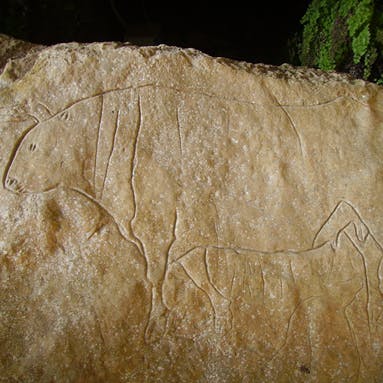
The traits of this magnificent mammal of grand stature
The auroch was the continent’s heaviest land mammal, by Julius Caesar's account were 'little below the elephant in size'. Besides historical accounts, we are able to rely on a wealth of sources from archaeology to cattle genetics to build a picture of aurochs.
Bulls were notably larger than cows, weighing up to 1000kg with average heights between 1.55 cm and 1.80 cm (cows 135-155 cm). They had a light-coloured muzzle (nose, mouth and jaws) and long legs fit for walking long-distances. Face an auroch head-on and you would have been struck by its large skull with impressive long and thick curved horns (up to 107cm long/18cm thick). Despite their size, aurochs were agile, athletic animals capable of defending themselves against predators such as wolves.
Aurochs were able to adapt and live in various ecosystems across Europe including swamps, forests, steppes and mountains, although not in boreal forests like modern cattle. Their diet consisted of grasses, herbs, leaves, foliage, and acorns in winter. They lived in herds of up to 30 animals and had a lifespan of 25 to 30 years.
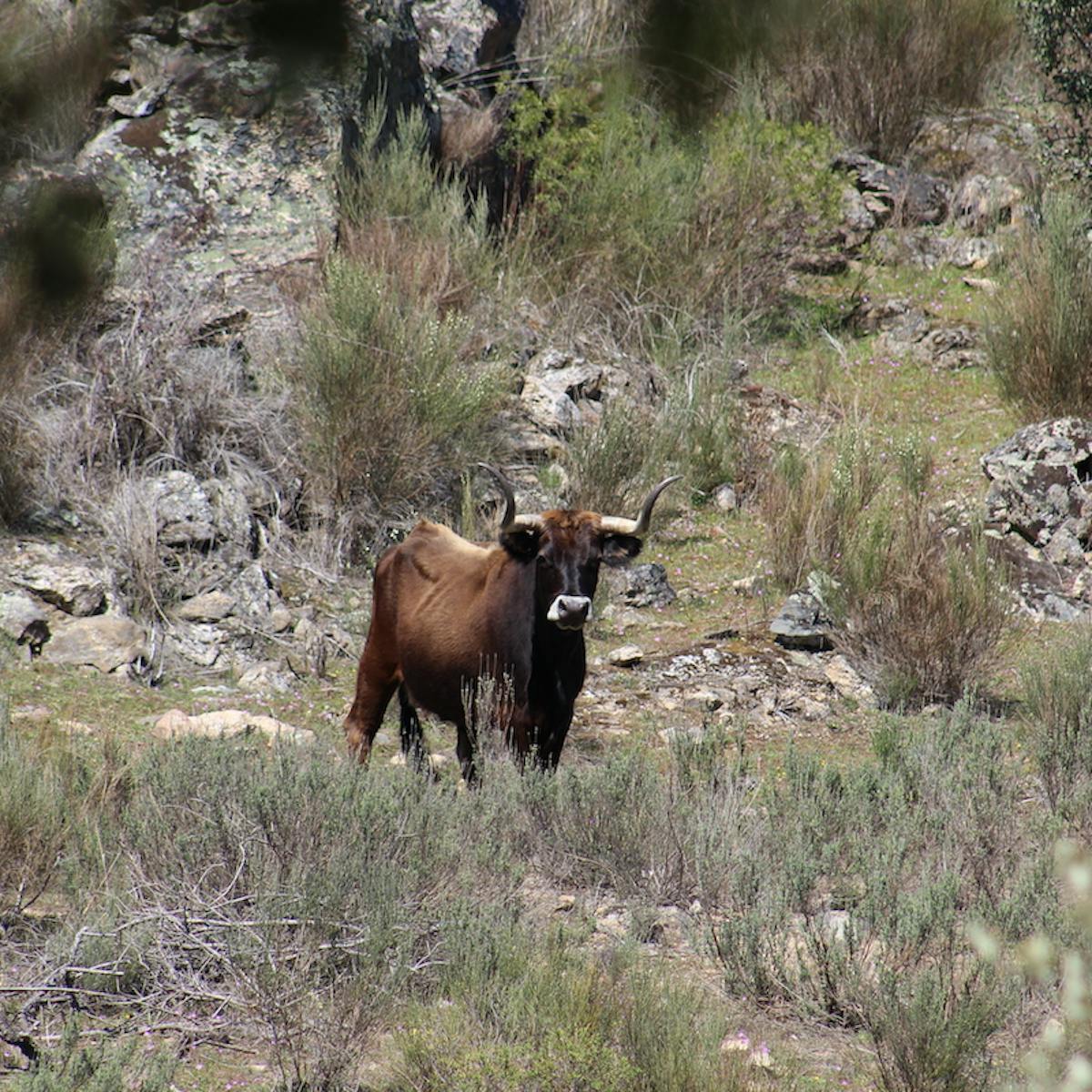
How did aurochs compare to other cattle?
Aurochs are hailed as the ancestors of all modern cattle. One study narrows this lineage down to the domestication of 80 wild female aurochs in the Near East some 10,500 years ago. Three subspecies of wild aurochs have been identified: the Eurasian aurochs, the North African aurochs, and the Indian aurochs.
The modern domesticated taurine cattle breeds or European cattle are said to have come from the Eurasian aurochs. The North African aurochs were structurally similar to the Eurasian aurochs. The Indian aurochs were the first subspecies to exist and were domesticated as the zebu cattle.
Bison paving the path
A fellow member of the Bovidae family, bison are often confused with aurochs. There is a reason for this, they share similarities in behaviour as natural grazers and in size (up to 920 kg), but morphologically they clearly differ. Their stories are familiar though - both suffered at the hands of humans - only two populations of European bison survived up to the 20th century. Rewilding efforts to reintroduce bison have thankfully helped build populations, around 7,000 wild or semi-wild bison roam areas in Poland, Germany, France, and Spain.
Find out what it's like to see bison up close as Mossy Earth co-founder Duarte, has an encounter with a herd of bison on a Baltic Sea island or learn more about the return of the European bison and how, here at Mossy Earth, we are helping by monitoring reintroduced bison.
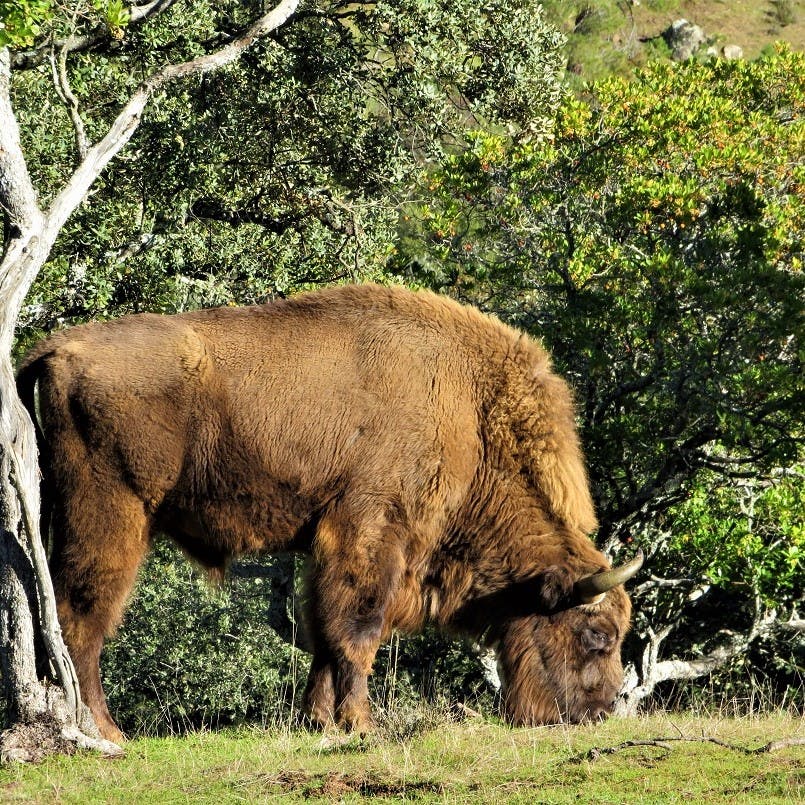
The extinction of aurochs
Sadly, the familiar pattern of harmful human impact played out for aurochs too. Disease passed from domesticated livestock, over-hunting, and habitat degradation had already led to a decline of the species by the 13th century. With time, their range was further restricted, leaving only a small population in a royal hunting reserve in Poland’s Forest of Jacktorów, which became extinct in 1627. It is said aurochs in Britain died out way before, during the Bronze Age.
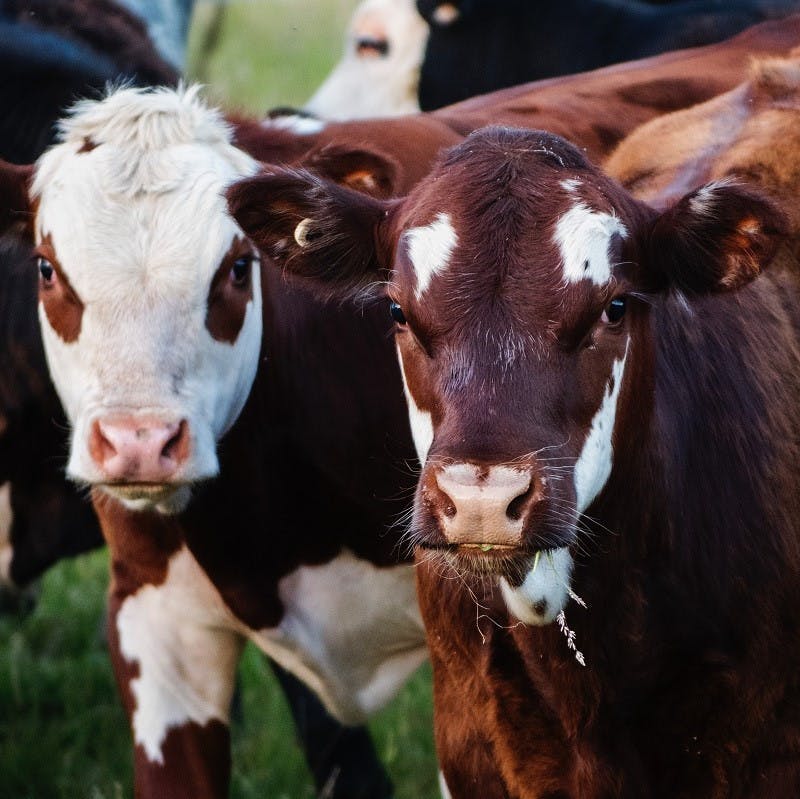

Take action now
Do you want to have a direct impact on climate change? Sir David Attenborough said the best thing we can do is to rewild the planet. So we run reforestation and rewilding programs across the globe to restore wild ecosystems and capture carbon.
Get involved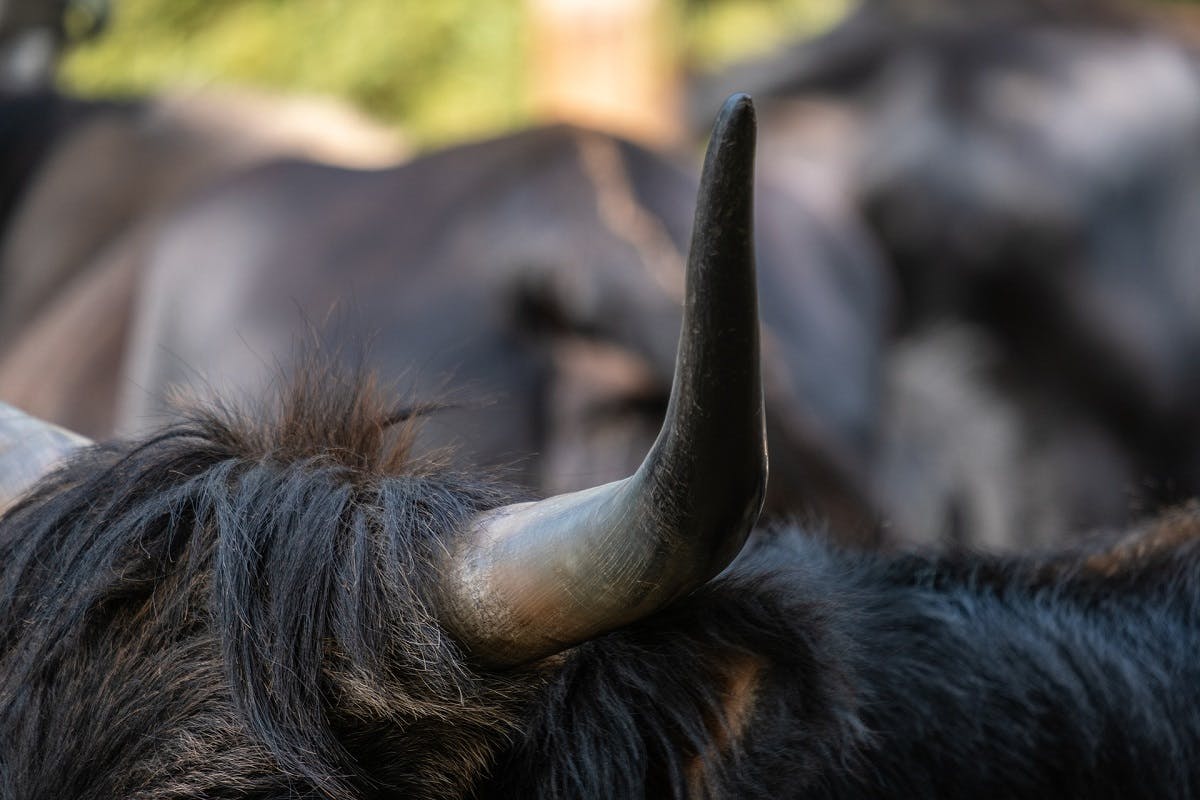
Why bring aurochs back from the dead?
They were extremely important for our progression as a species, but with modern cattle supporting today’s agricultural needs, why are we trying to resurrect aurochs? And what are the associated risks of their de-extinction?
In this chapter of our history, when a climate catastrophe beckons, we are turning to aurochs to play a leading role in protecting and restoring nature.
How aurochs can save ecosystems: a keystone species
The research teams behind this bold move to revive this extinct bovine believe aurochs can prevent the loss of habitats and positively affect biodiversity in Europe. They have a profound and defining impact on their environment in various ways, this is why they are known as a 'keystone species' in ecology.
For many thousands of years, large wild herbivores grazed and browsed Europe's lands which created open spaces for other life to prosper. Aurochs, a heavyweight grazer of vegetation, prevented landscapes from becoming intensely forested. Maintaining diverse landscapes from open soil to grasslands was deemed possible thanks to the daily grind of such herbivores. Bison and wild horses are other examples of herbivores who importantly shape ecosystems providing open and semi-open habitats for various flora and fauna. Therefore, reviving aurochs and reinstating them to this role in these habitats is vital for biodiversity - an impact of significance in the UN Decade on Ecosystem Restoration.
Other ecological benefits of reviving aurochs
Besides grazing, these “ecological engineers” help species of animals, plants, and insects thrive in many other ways, such as:
- The disturbed soil after auroch's grazing and trampling makes space for pioneer plants to sprout.
- Smaller herbivores such as deer can find protection from predators in auroch herds.
- Birds can feed on cattle insects or use the fur to build nests.
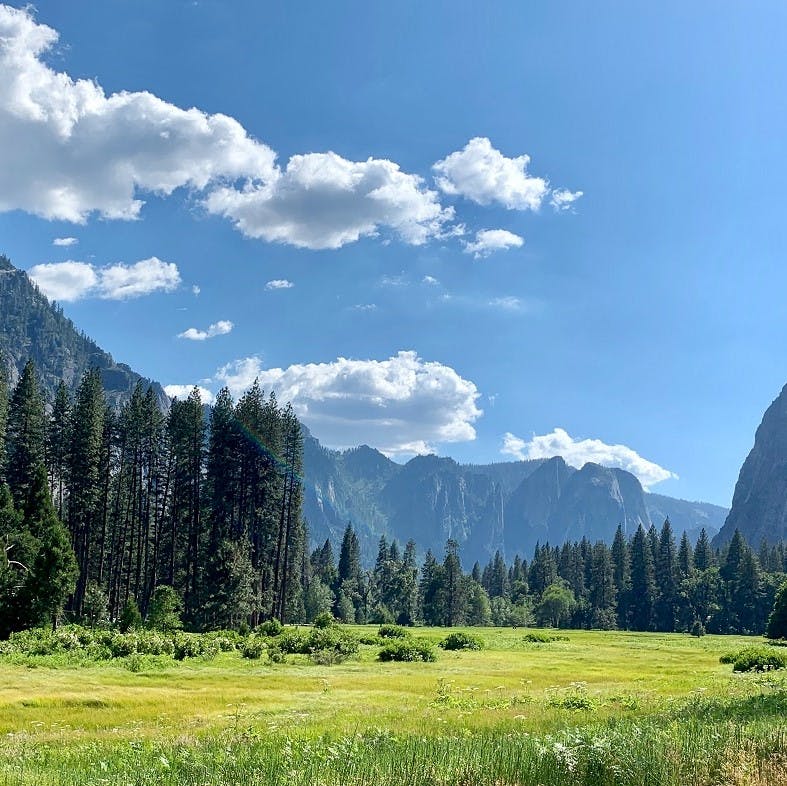
Why resort to an extinct species?
Since the Early Pre-Pottery Neolithic period large, wild herbivores like aurochs had been slowly replaced by domesticated livestock herds. Occupying much of Europe’s landscape, the domesticated cattle continued a similar pattern of large-scale grazing until recently. Now, a range of factors, including increased urbanization and poor agricultural viability, has led to high levels of rural land abandonment in Europe. This increasing trend runs the risk of leaving land under-grazed or not at all, transforming it into a barren landscape. If this is an eventuality, it poses a great threat to the survival of biodiversity in these areas.
This concern has spurred ecologists into finding a solution, and the return of the auroch is one avenue they are pursuing.

We thought we needed a grazer that is fully self-sufficient in case of big predators...and could do the job of grazing big wild areas [...] We reasoned that this animal would have to resemble an auroch.
Ecologist Ronald Goderie, Tauros programme
Return of the aurochs
The aurochs filled an important role in Europe’s ecosystems and, though they have gone extinct, their genes are still present in modern cattle. Scientists have been trying to bring them back to life via a process known as back-breeding: crossbreeding domestic cattle with similar characteristics to their auroch ancestors. These include large stature, long legs, a slender and athletic build, horns curving forward, black coats in the males and reddish brown ones in females. Not forgetting, researchers are seeking to replicate the auroch's behaviours and genetics. The DNA analysis of a 6,700 year old auroch fossil is aiding the search.
The first attempt to bring back the auroch was made in the 1920s by German biologists Heinz and Lutz Heck. The result was a breed called the Heck cattle, with some resemblance to the original species. Today, rewilding projects are using a variety of domestic cattle breeds to fulfill the role of the auroch, like Heck cattle and Highland cattle. More recently attempts have been made to achieve a breed that is closer to the auroch.
- Tauros Programme by the Taurus Foundation in collaboration with Rewilding Europe and European Wildlife
- Taurus Project by the Arbeitsgemeinschaft Biologischer Umweltschutz in Germany
- Uruz Project by the Nature Foundation, in Spain and Portugal
- Wetlands project by Ministry of Natural Resources and Environmental Protection of Belarus, GEF and UNDP
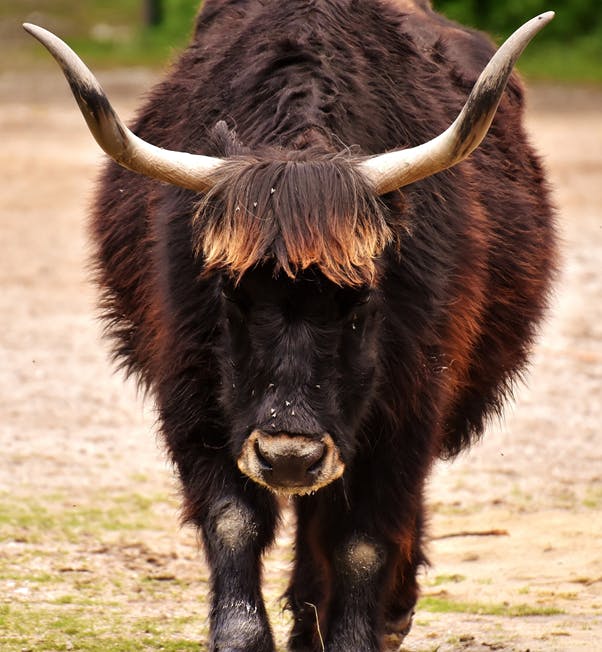
Tauros Programme
The dutch-based Tauros Programme is the largest initiative so far with their modern auroch named 'Tauros'. The programme's aim is to selectively breed the Tauros so they serve the niche function of natural grazing and therefore, sustaining 'a rich mosaic of open landscapes'.
Breeding of Tauros is happening in six different countries: Spain, Portugal, Croatia, Czech Republic, Romania and the Netherlands and in 2017 there were over 600 animals, 400 of these are part of the European Wildlife Bank.
A free roaming bovine
Though a domesticated breed of cattle, the Tauros will act very much like its wild ancestors. The programme envisages having these free-roaming, self-sufficient herbivores grazing in large herds (more than 150) across various rewilding sites in Europe in the next 20 years. They have the ability to defend themselves from predation by carnivores such as wolves and bears, but some will inevitably be preyed upon by wild carnivores thereby restoring natural food chains.
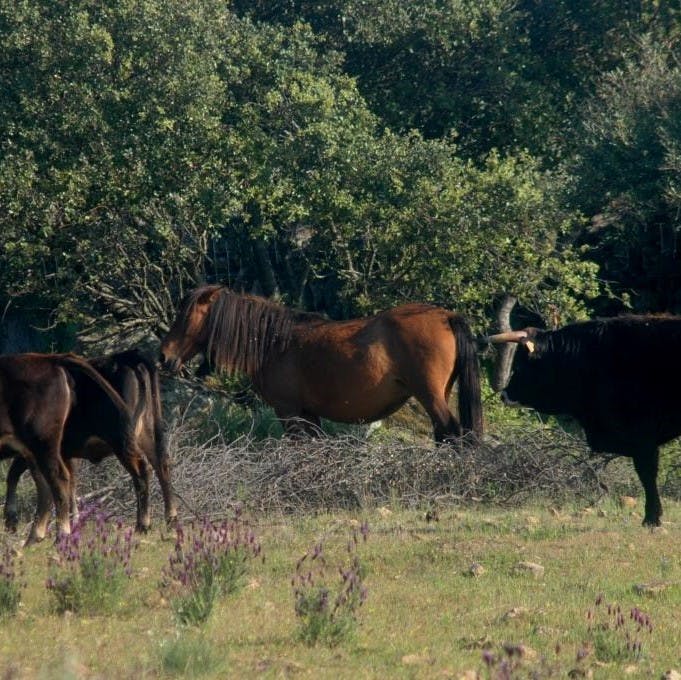
What could go wrong with resurrecting and releasing aurochs?
Valid concerns of de-extinction processes have been raised to foresee complications and avoid negative consequences. The associated risks of reintroducing species such as aurochs have been presented in an article that applies the framework generated by the International Union for the Conservation of Nature’s (IUCN): Guidelines on Reintroductions and Other Conservation Translocations. Some of the key considerations raised in the article include,
- Diseases: unknown rare diseases could be accidentally selected for breeding and passed onto the recreated species. De-extinct species are also at risk if they don't have resistance to new pathogens.
- Suitable release site: successful reintroductions require the correct habitat and range to be available now and in the future.
- Social feasibility and human concerns: the former relates to potential issues in policy and legislation, for instance if there are national veterinary requirements for new animals. The latter, questions the level of support from communities, and to what extent there will be impacts on local culture, economy and health. Fears of predatory attacks on people are common, while opportunities exist for local businesses through nature-based tourism.
- Ecological risk: although the primary goal of bringing back aurochs is ecological enrichment, caution is needed to avoid negative impacts on existing ecosystems. One area to monitor is inter-specific hybridization that can lead to genetic-based extinction of current animals.
Others points of discussion have also risen from the following areas of concern.
- Bio-objectification: where life is made into an object by humans. An ethical debate exists on whether organisms born out of extinction reversal procedures classify as bio-objects, used and controlled for human purposes.
- Identification of de-extinct species: As remade species may not possess the exact characteristics of extinct ones, the procedure of determining identity is open to discussion.
- De-extinction techniques could stifle the will to protect existing species.
- Some hold moral views against the notion of de-extinction itself, believing in a 'finality', where only new human-made species can derive from de-extinction projects.

Conclusion
The idea of bringing an extinct species back to life automatically stirs excitement in many of us. To witness a beast from ancient times, when our planet was vastly different from today, roam our lands once again is a romantic vision. However, does it justify the possible risks of de-extinction backfiring on us?
The rapid rate of land abandonment in Europe spells disaster for many species. Researchers have been proactively exploring solutions through back-breeding and reintroductions of other large herbivores. By drawing on the expertise of a wide range of scientific fields, teams pioneering back-breeding have converged to progress towards their goals in the quickest time possible. Being very aware of the cost of inaction, leading programmes have already gone some way in addressing the major concerns of de-extinction. Breeds are selected to best suit and adapt to local food, climate, and predators in initiatives such as the Tauros programme.
That's not to say the path is clear of challenges, far from it. Success depends multiple factors, of which some could be unforeseen. More research will undoubtedly help success rates by providing new information, and lessons can be learnt from reintroductions of other large grazers like European bison.
What can be ascertained though is the auroch is a strong candidate for the role of a super species in this circumstance. To come to our aid once more, but this time to restore ecosystems that will build resilience against climate change.
Glossary of terms
Animal Husbandry: The study and science of breeding domesticated farm animals.
Biodiversity: Standing for biological diversity - it refers to all plant and animal species in an area and their abundance. A high level of species diversity is important, the more abundant and diverse, the better.
Domestication: A process humans have created that leads to the taming of animals or plants, which can result in their complete dependence on humans for their survival. It is engendered by breeding methods which will see the most human friendly animals chosen to breed.
Ecosystem: A community of biological organisms such as animals, plants, fungi and how they interact with one other and the environment they live in. Ecosystems have biological, physical and chemical components and come in endless forms.
Food Chains: The link of animals that depend on one another for food sources. Animals at the bottom will feed on grasses and plants (which serves its own ecological function), they in turn will be eaten by mesopredators who are in the middle of the food chain. These in turn will be predated upon by apex predators who have no natural predators.
Keystone Species: Coming in many forms, they are organisms whose relationship with its environment can shape the entire ecosystem. If they were removed, it could lead to an ecosystem becoming severely altered or collapsing. Examples of keystone species are birds of prey, wolves, beavers and bees.
Sources & further reading

- “Return of the Aurochs” - Jonathan Keats
- “The quest to revive extinct Aurochs to restore ancient lands” - Mihnea Tanasescu
